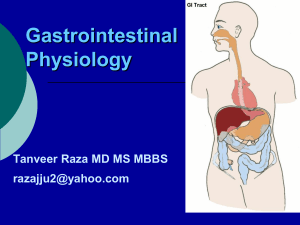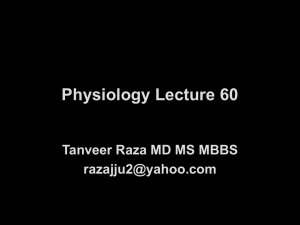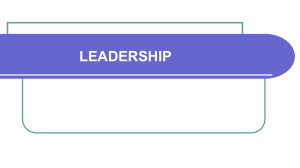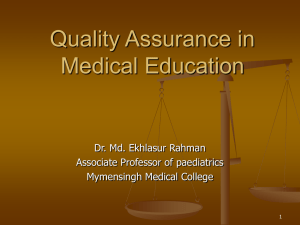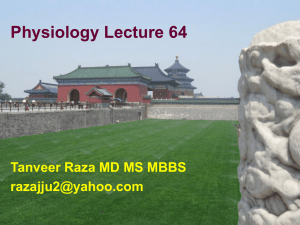Humoral Control of the Circulation
advertisement
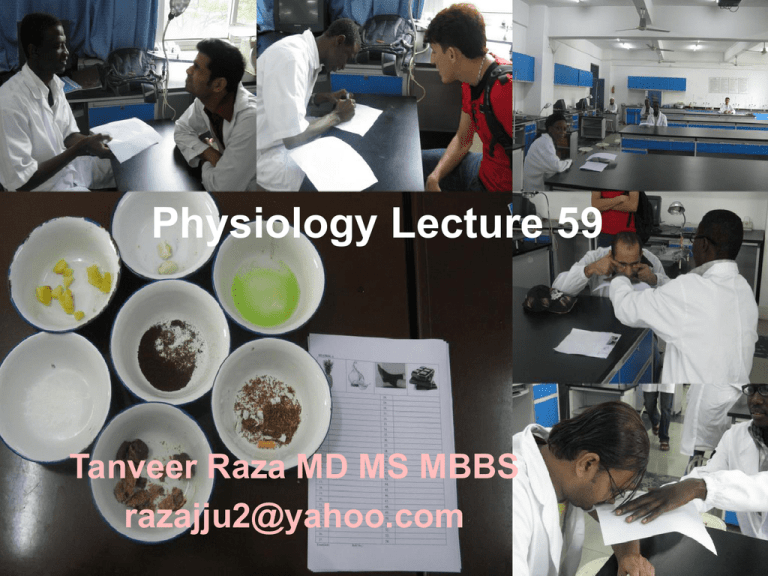
Physiology Lecture 59 Tanveer Raza MD MS MBBS razajju2@yahoo.com Tanveer Raza MD MS MBBS razajju2@yahoo.com Local Blood Flow • Control – Acute control • Vasodilation/vasoconstriction of arterioles, metarterioles, and precapillary sphincters • Very rapid – Long-term control • Increase/decrease in size and number of blood vessels • Slow Tanveer Raza MD MS MBBS razajju2@yahoo.com Local Blood Flow: Acute Control Figure: Diagram of a tissue unit area for explanation of acute local feedback control of blood flow, showing a metarteriole passing through the tissue and a sidearm capillary with its precapillary sphincter for controlling capillary blood flow. Tanveer Raza MD MS MBBS razajju2@yahoo.com Local Blood Flow: Acute Control • Effect of Tissue Metabolism – Increased metabolism increases blood flow • Oxygen Availability – Decreased 02 availability increases flow • Acute increase in arterial pressure Tanveer Raza MD MS MBBS razajju2@yahoo.com Local Blood Flow: Acute Control Figure: Effect of increasing rate of metabolism on tissue blood flow Tanveer Raza MD MS MBBS razajju2@yahoo.com Local Blood Flow: Acute Control Figure: Effect of decreasing arterial oxygen saturation on blood flow through an isolated dog leg Tanveer Raza MD MS MBBS razajju2@yahoo.com Local Blood Flow: Acute Control Effect of different levels of arterial pressure on blood flow through muscle. Solid red curve shows effect if arterial pressure raised over a period of a few minutes. Dashed green curve shows arterial pressure is raised extremely slowly (many weeks) Tanveer Raza MD MS MBBS razajju2@yahoo.com Local Blood Flow: Acute Control • Effect of Tissue Metabolism • Oxygen Availability • Acute increase in arterial pressure – Immediate rise in blood flow. But, within less than a minute, blood flow returns almost to the normal level, even though the arterial pressure is elevated (autoregulation of blood flow) Tanveer Raza MD MS MBBS razajju2@yahoo.com Local Blood Flow: Acute Control • Effect of Tissue Metabolism • Oxygen Availability • Acute increase in arterial pressure – Autoregulation of blood flow • The metabolic theory – High arterial pressure causing excess flow provides too much O2 and nutrients. These constricts blood vessels and flow returns nearly to normal despite raised pressure • The myogenic theory Tanveer Raza MD MS MBBS razajju2@yahoo.com Local Blood Flow: Acute Control • Effect of Tissue Metabolism • Oxygen Availability • Acute increase in arterial pressure – Autoregulation of blood flow • The metabolic theory • The myogenic theory – High arterial pressure stretches vessel wall, causing reactive vascular constriction that reduces blood flow nearly back to normal Tanveer Raza MD MS MBBS razajju2@yahoo.com Local Blood Flow: Acute Control • Special Consideration – Kidneys • Tubuloglomerular feedback – Feedback signals from macula densa cause constriction of afferent arterioles. Reducing renal blood flow and glomerular filtration rate back to or near to normal Tanveer Raza MD MS MBBS razajju2@yahoo.com Local Blood Flow: Acute Control Tanveer Raza MD MS MBBS razajju2@yahoo.com Local Blood Flow: Acute Control • Special Consideration – Brain • In addition to tissue O2; CO2 and H+ concentrations are very Important – Dilates cerebral vessels Tanveer Raza MD MS MBBS razajju2@yahoo.com Local Blood Flow: Acute Control Relationship between arterial Pco2 and cerebral blood flow Tanveer Raza MD MS MBBS razajju2@yahoo.com Local Blood Flow: Acute Control • EDRF – Endothelium-Derived Relaxing Factor • Mainly Nitric Oxide (NO) – Increases Blood Flow in upstream arteries – Released from endothelial cells lining the arterioles and small arteries Tanveer Raza MD MS MBBS razajju2@yahoo.com Local Blood Flow: Long Term Control • Change in "Tissue Vascularity" – Occurs during –Growth –Scar tissue –Cancerous tissue Tanveer Raza MD MS MBBS razajju2@yahoo.com Local Blood Flow: Long Term Control • Change in "Tissue Vascularity" – Growth Factors (Angiogenic Factors) • Vascular Endothelial Growth Factor (VEGF) • Fibroblast growth factor • Angiogenin Certain substances have opposite effect on small blood vessels, ex: Some steroid hormones Tanveer Raza MD MS MBBS razajju2@yahoo.com Local Blood Flow • Collateral Circulation Fig: Translumbar aortography in acute occlusion of the infrarenal aorta. The intercostal arteries (arrows) serve as major collaterals Tanveer Raza MD MS MBBS razajju2@yahoo.com Local Blood Flow: Long Term Control • Collateral Circulation – When an artery or a vein is blocked, a new vascular channel usually develops around the blockage and allows at least partial blood supply Tanveer Raza MD MS MBBS razajju2@yahoo.com Tanveer Raza MD MS MBBS razajju2@yahoo.com Humoral Control of the Circulation • Vasoconstrictor Agents – Norepinephrine (NE) and Epinephrine (E) – Angiotensin II – Vasopressin – Endothelin Tanveer Raza MD MS MBBS razajju2@yahoo.com Humoral Control of the Circulation • Vasoconstrictor Agents – Norepinephrine (NE) and Epinephrine (E) • NE powerful vasoconstrictor hormone • E is less powerful, in some tissues even causes mild vasodilation – E vasodilates coronary arteries during increased heart activity Tanveer Raza MD MS MBBS razajju2@yahoo.com Humoral Control of the Circulation • Vasoconstrictor Agents – Norepinephrine (NE) and Epinephrine (E) • Sympathetic stimulation – To nerve endings in individual tissues release NE, which excites the heart and contracts veins and arterioles – To adrenal medullae secrete both NE and E Tanveer Raza MD MS MBBS razajju2@yahoo.com Humoral Control of the Circulation • Vasoconstrictor Agents – Angiotensin II • Powerful vasoconstrictor – Constrict powerfully the small arterioles • Increase total peripheral resistance, – Increases the arterial pressure (Regulates BP) Tanveer Raza MD MS MBBS razajju2@yahoo.com Humoral Control of the Circulation • Vasoconstrictor Agents – Vasopressin • a.k.a. Antidiuretic hormone (ADH) • More powerful than angiotensin II as a vasoconstrictor • Formed in nerve cells in hypothalamus of the brain Tanveer Raza MD MS MBBS razajju2@yahoo.com Humoral Control of the Circulation • Vasoconstrictor Agents – Endothelin • Powerful Vasoconstrictor in Damaged Blood Vessels – Usual stimulus for release is damage to the endothelium Tanveer Raza MD MS MBBS razajju2@yahoo.com Humoral Control of the Circulation • Vasodilator Agents – Bradykinin – Histamine Tanveer Raza MD MS MBBS razajju2@yahoo.com Humoral Control of the Circulation • Vasodilator Agents – Bradykinin • Causes both powerful arteriolar dilation and increased capillary permeability • Powerful vasodilator – Once formed persists for only few minutes Tanveer Raza MD MS MBBS razajju2@yahoo.com Humoral Control of the Circulation • Vasodilator Agents – Bradykinin • Plays special role in – Inflammation – Regulate blood flow in » Skin » Salivary glands » Gastrointestinal glands Tanveer Raza MD MS MBBS razajju2@yahoo.com Humoral Control of the Circulation • Vasodilator Agents – Histamine • Released in essentially every tissue of the body – Damaged tissue – Inflammation – Allergic reaction • Powerful vasodilator increase greatly capillary permeability Tanveer Raza MD MS MBBS razajju2@yahoo.com Humoral Control of the Circulation • Vasodilator Agents – Histamine • Most of the histamine is derived from mast cells in the damaged tissues and from basophils in the blood. Tanveer Raza MD MS MBBS razajju2@yahoo.com Humoral Control of the Circulation • Ions and Other Chemical Factors – Ca++ – K+ – Mg++ – H+ – Anions – CO2 Tanveer Raza MD MS MBBS razajju2@yahoo.com Humoral Control of the Circulation • Ions and Other Chemical Factors – Ca++ • Increase causes vasoconstriction – K+ • Increase causes vasodilation – Inhibit smooth muscle contraction. – Mg++ • Increase causes vasodilation – inhibit smooth muscle contraction. Tanveer Raza MD MS MBBS razajju2@yahoo.com Humoral Control of the Circulation • Ions and Other Chemical Factors – H+ • Increase (decrease in pH) causes dilation of the arterioles. – Anions • Acetate and citrate – cause mild degrees of vasodilation Tanveer Raza MD MS MBBS razajju2@yahoo.com Humoral Control of the Circulation • Ions and Other Chemical Factors – CO2 • Increase causes moderate vasodilation in most tissues, but marked vasodilation in the brain • CO2 in blood, acting on brain vasomotor center, has an extremely powerful indirect effect, transmitted through the sympathetic nervous vasoconstrictor system, to cause widespread vasoconstriction throughout the body Tanveer Raza MD MS MBBS razajju2@yahoo.com Nervous Regulation of Circulation • Blood flow control is mainly local • Nervous control of circulation has more global functions – Redistributing blood flow to different areas of body – Increasing/decreasing heart pumping – Very rapid control of systemic arterial pressure Tanveer Raza MD MS MBBS razajju2@yahoo.com Nervous Regulation of Circulation • Nervous system controls almost entirely through autonomic nervous system (ANS) – Sympathetic • More Important for circulation control – Parasympathetic • Regulates heart function Tanveer Raza MD MS MBBS razajju2@yahoo.com Anatomy of sympathetic nervous control of the circulation. Also shown by the red dashed line is a vagus nerve that carries parasympathetic signals to the heart. Tanveer Raza MD MS MBBS razajju2@yahoo.com Thank You

